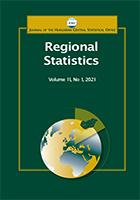External public debt and economic growth relationship: Evidence from developing Sub-Saharan African countries, 1980–2018
External public debt and economic growth relationship: Evidence from developing Sub-Saharan African countries, 1980–2018
Author(s): Bunde Aggrey OtienoSubject(s): Social Sciences, Economy, Geography, Regional studies
Published by: Központi Statisztikai Hivatal
Keywords: external public debt; economic growth; ARDL; VAR; Sub-Saharan Africa
Summary/Abstract: This study empirically evaluates external public debt and economic growth relationships in the Sub-Saharan African region; it anchors on the classical, neoclassical, and Keynesian economic growth theories. Given the lack of consensus amongst researchers from different countries, several research outputs on external public debt have yielded conflicting results. Based on the World Development Indicators (WDI) panel dataset for 1980–2018, this study applies Autoregressive Distributed Lagged Model (ARDL) using balanced cross-sectional panels. The study makes a novel contribution using vector autoregression (VAR), impulse response functions (IRF), and variance decomposition to show the impact of external public debt innovation shocks on economic growth. The findings of this study support classical economists and Keynesian conflicting views on economic growth and the external public debt relationship. The results reveal a positive and statistically significant long-run relationship between external public debt and economic growth in the countries studied. A positive short-run and negative long-run relationship between economic growth and external public debt are observed in Kenya and Nigeria. These findings are consistent with the classical economist’s stance, suggesting that public debt hampers economic growth. Conversely, Keynesian propositions are confirmed in Malawi, Botswana, and Lesotho, where external public debt has a negative short-run and positive long-run impact on economic growth. Most of these countries responded differently in terms of growth, which may be attributed to the differences in financial deepening, quality of institutions governing fiscal and monetary policies, and trade openness. This study’s empirical results imply that policymakers should focus on a stable fiscal and monetary policy framework. This is possible by ensuring debt sustainability with a sound and secure macroeconomic policy environment in the selected countries.
Journal: Regional Statistics
- Issue Year: 13/2023
- Issue No: 05
- Page Range: 824-862
- Page Count: 39
- Language: English

